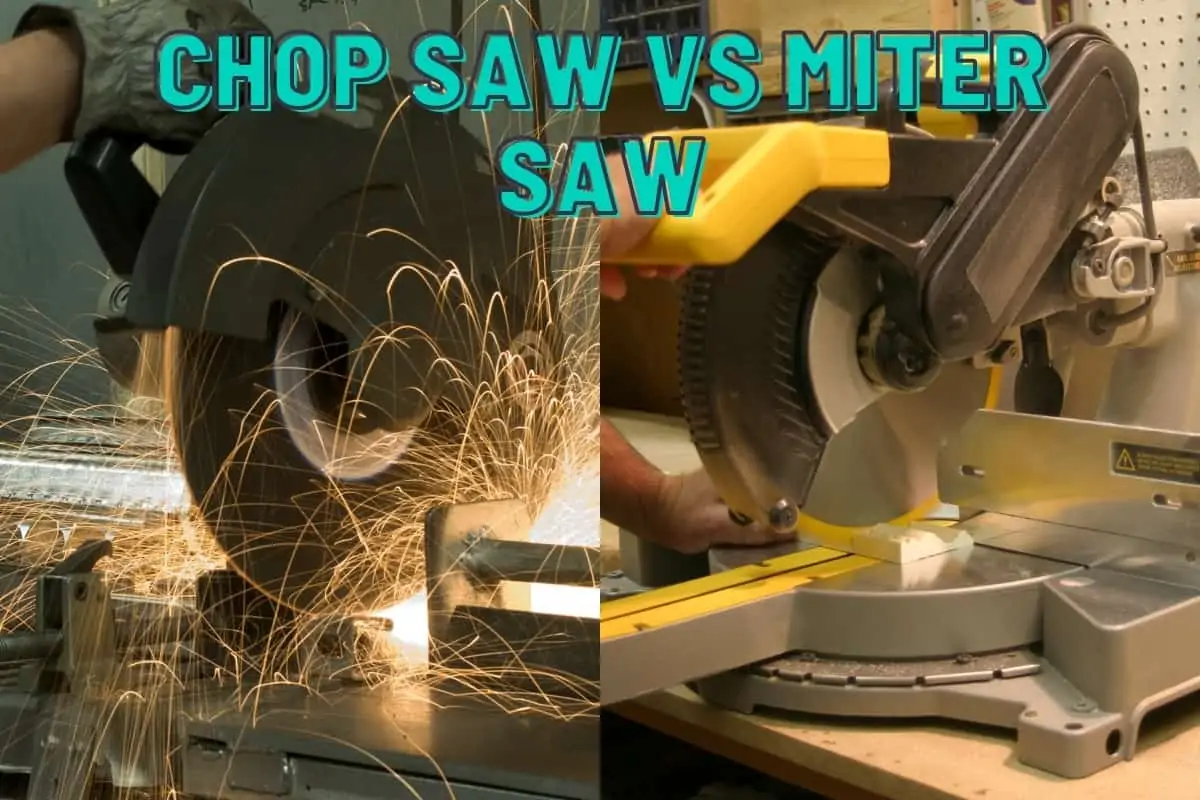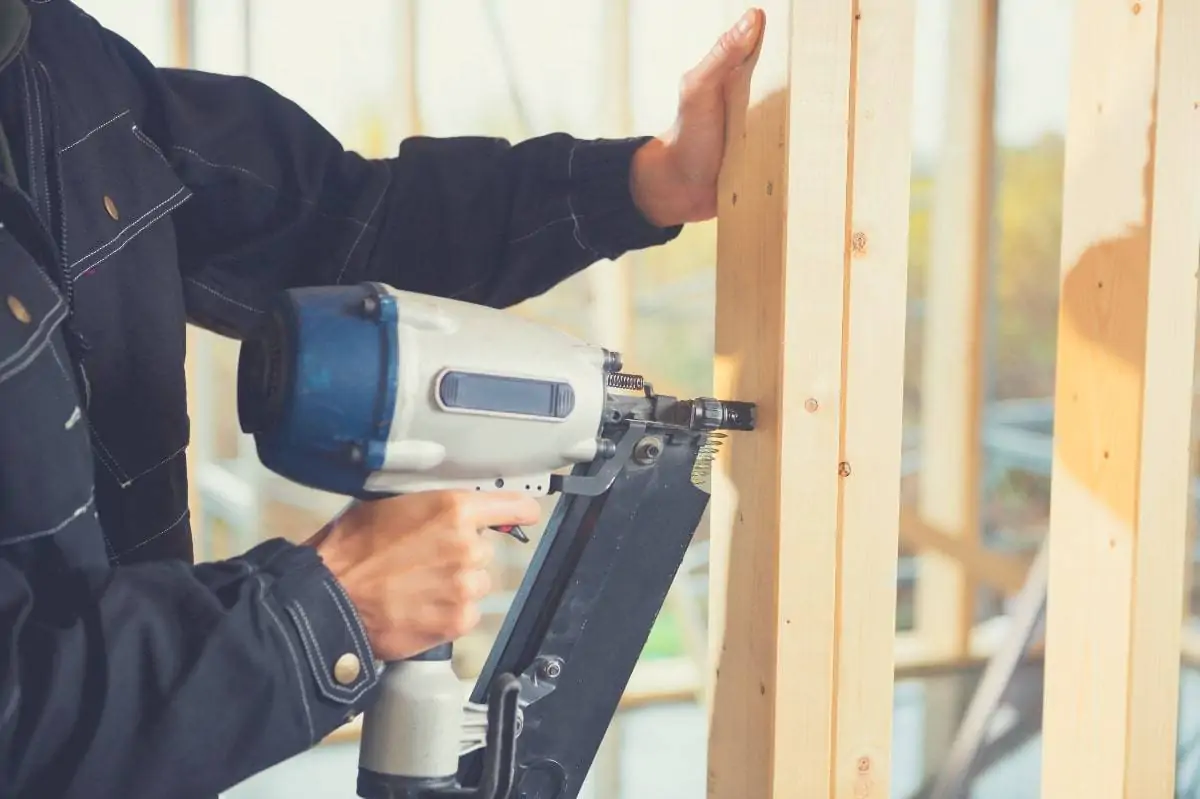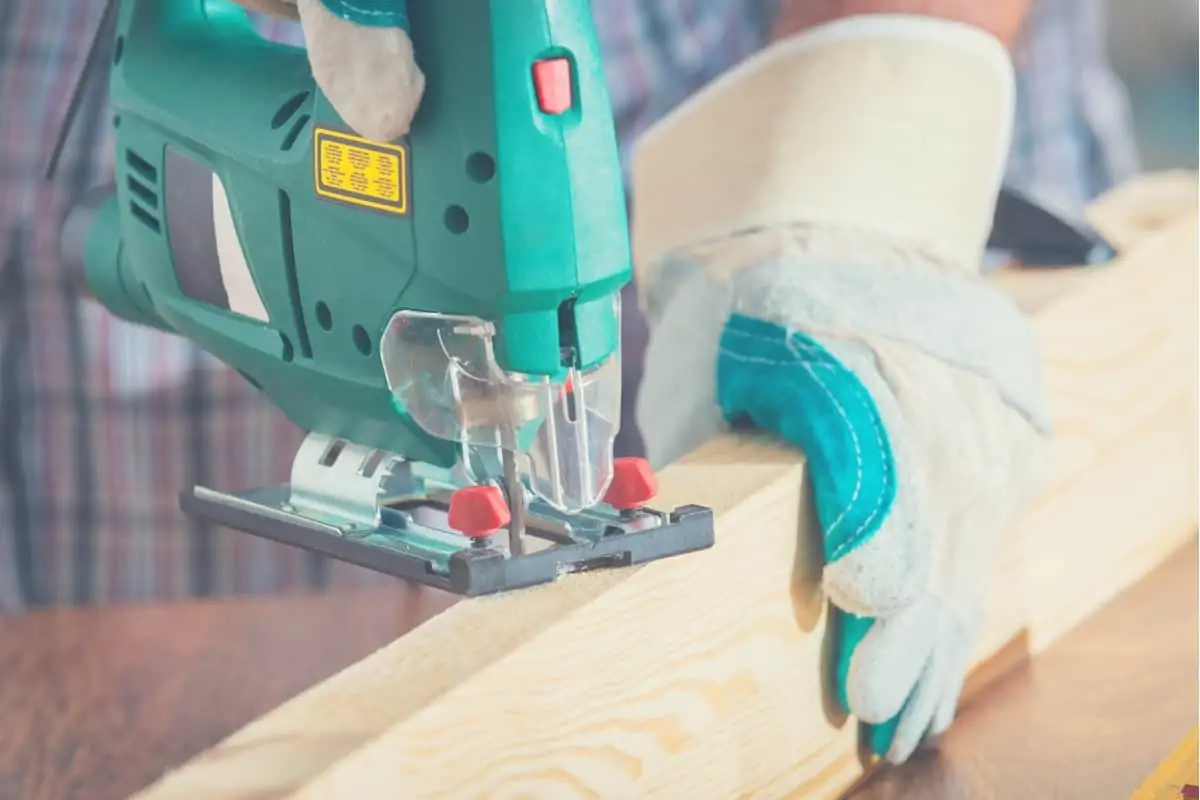When it comes to weighing up the primary function between a miter vs chop saw are very similar, but there are some significant differences. If you’re thinking about buying either one, an awareness of these variations will ensure you purchase the best tool for your needs.
Both types of saw use blades that are circular and cut from the top to the bottom in a drop-down motion. Chop saws tend to be more powerful and larger than miter saws. They are more commonly used in industrial shops and commercial settings. They’ll be used for cutting large amounts of heavy-duty pieces.
Miter saws tend to be used for projects in the home, various home improvement jobs, and general-purpose woodworking. A defining feature of a miter saw is that it can produce a neat finish on pieces of material that are smaller. You can use it for cutting molding, picture and door frames, and trim.
In this chop saw vs. miter saw guide, I’m going to look closely at each of these valuable tools and highlight the factors you should consider when choosing one. I’ll also get you better acquainted with some of the jobs you can use them for.
Miter Saw
A miter saw is smaller than a chop saw. It’s also more specialized at making cuts at different angles and doing it quickly. You can also use it to make bevel and miter cuts. It’s a highly accurate power tool which repeatedly delivers precise cuts.
Miter saws can be purchased in either 10” or 12” options. If you want the best bang for your buck, a 10” model is best suited for general purpose work, and you’ll be able to use it for most DIY, and home-improvement projects.
A 10” blade should be competent enough to make cuts in boards up to 5½” thick. Whereas a 12” blade should be able to cut boards that are 7½” thick.
Other options for buying a miter saw include sliding, compound, and dual compound models. The range of miter saws you can buy allows for increased versatility. Miter saws come in a variety of sizes, some of which are rather large and heavy and need a special stand or designated area on your workbench.
Uses
If you’re wondering whether you need a miter saw, let me explain how best to use it.
You can use a miter saw for making angled cuts, for example, on the horizontal plane. Depending on the model, it may also be possible for you to perform bevel cuts vertically through the wood’s thickness.
You use a miter saw primarily for cutting wood, baseboards, crown molding, and similar craft projects such as making shelves, boxes, or picture frames.
Here are some of the most common uses for your band saw:
- Regular cross cuts: A miter saw works very well if you want to cut a board in half. It’s a powerful and stable tool, and you can line up the cut line very easily. Using a sliding miter saw, you can cut boards of 12” or more.
- Angled cuts: Also known as miter cuts, you cut by turning the saw at an angle. The range of cut is usually around 50° to the right and the left. A miter joint plays a key role when building things such as picture frames. Trim work also requires different angles, together with flooring and other DIY projects.
- Bevel and compound angle cuts: This type of cut is more complicated to make but is handy for complex angles.
- Repeatable cuts: Put a stop at one end of your work surface, and you can make repeatable cuts effortlessly.
- Built into a workbench: It’s easy to integrate a miter saw into a workstation. It will allow you to position and hold boards in place effortlessly.
- Sliding saw: Use a sliding miter saw, and you can cut wide pieces of wood.
How you use a miter saw depends on the type of saw. Basically, there are three types to choose from: basic, compound, and sliding compound.
You can’t use a basic miter saw for cutting bevels. However, you can still make accurate miters and crosscuts. It tends to be much lighter and more straightforward than other types and is generally more affordable.
A compound miter saw has two additional options. It can be single or dual bevel. With this saw, you can make a wide range of cuts, including crosscuts, compound, bevel, and miter cuts. It is, however, more challenging to use and is often more expensive.
The third option is a sliding compound miter saw which is much more elaborate than previous options. It is very similar to a compound miter saw but has a sliding arm. What this means is that it can make longer cross cuts.
How it Works
A miter saw has a round blade that’s mounted on an arm that’s hinged. The blade swivels, so you can use it to make angled cuts and a variety of other cuts. To make a cut, you hold the material against the fence and secure its position. You then bring the blade down onto the wood in a short, controlled motion, at 90°.
If you want to make an angled cut, you simply adjust the angle of the blade. The increments are often one or half a degree, but many models allow you to use quick set stops for the most common angles, such as 15°, 30°, and 45°.
If you’d like to see what’s inside a miter saw, take a look at this video:
Accuracy and User Friendliness
A miter saw is a very accurate tool to use. You can angle it to your exact specifications or use it to perform 90° cross cuts accurately.
Beginners shouldn’t have too many problems using a miter saw as it is easy to use. All you need to do is line the blade up correctly and hold your workpiece steady. If you’re making compound cuts, more complex settings may be required.
Potentially, miter saws can be dangerous if you don’t use them correctly. You will also need to wear eye and ear protection and follow several other miter saw safety rules.
Watch this video for some miter saw safety tips:
Cost
Compared with a chop saw, a miter saw is much cheaper. That being said, there are other saws available that perform the same tasks. A circular saw, for example, is much more versatile but lower in price.
Pros and Cons
There are several advantages to having a miter saw in your workshop, although there are some disadvantages you need to be aware of.
Pros
- Versatile: You can use it for cutting wood, aluminum, steel, and plastic.
- Cutting angles: You can swivel the blade to make angled cuts.
- Cleaner: The size and width of the blade allow you to make clean, fine, and smoother cuts.
- Safer: They are considered to be low-hazard power tools because the material is held in a stationary position while the saw arm moves. There is also less of a risk of kickback.
Cons
- Limited for bigger work: A miter saw is not suitable for cutting large pieces of wood.
Chop Saw
Chop saws are a much more powerful and aggressive machine, most commonly used for cutting metal. The motor that powers the tool is larger and the blade bigger than those used in a miter saw. You can use it to cut through lumber, but it works best if you’re cutting thick or large sections of metal.
One primary difference between a chop and a miter saw is that it can only make cuts that are 90-degree. One other significant difference is that a chop saw utilizes an abrasive disc rather than sharp edges or teeth.
Chop saws mostly use a 14” disc, which is the cutting capacity needed for big projects such as cutting frameworks made from metal.
Uses
A chop saw makes easy work of cutting metal, composite materials, masonry, and wood. You can even use it to cut through timber that’s embedded with nails. It’s a popular tool with construction workers because of its immense power. Thanks to a cutting disc that has no teeth, it can also make exact cuts.
You cannot use a chop saw to cut angles. It can only make 90° cross cuts.
Some of the most common uses of a chop saw include:
- Cutting steel pipes, channels, and bars.
- Extensively used in construction work.
- Cutting many pieces to equal lengths, such as fencing.
- Cutting through solid metal bars.
With the right blade, you can also cut through wood. However, it might be considered a waste of the saw’s power. You have to use a different cutting disc because the standard metal cutting disc would get loaded and potentially break or even explode.
How it Works
A chop saw uses an abrasive disc fixed onto a swing arm. Before cutting, you first have to fix your piece onto the saw table. You can use a clamp to secure it in place or hold it with your hands.
Switch the cutting blade on using a trigger that’s located on the handle. You then pull the arm down to cut. Keep your finger pressed on the trigger until you’ve finished cutting and lifted the blade out.
Some chop saws are powered by hydraulics. The user controls the tool using a foot or knee switch, leaving both their hands free for feeding the material into the saw.
Accuracy and User Friendliness
You should find a chop saw relatively easy to use. The critical thing to remember is to fix your workpiece securely and at the proper distance before you bring the blade down to cut.
Chop saws haven’t been designed to make precise cuts. Rather, they are for cutting especially difficult materials, such as thick pipe and metal. They can be very powerful and tend to be used mainly by professionals.
Cost
Compared with a miter saw, a chop saw will likely to be the more expensive of the two. If you need to cut metal, a circular saw might be the cheaper option. It’s also going to be more versatile.
You will, however, need to purchase the right blade. It’s also possible to cut dense materials such as metal using a miter saw, provided you’ve upgraded your cutting blade.
Pros and Cons
Are you still struggling to decide whether a chop saw is suitable for you? Let’s take a quick look at some of the pros and cons.
Pros
- Very powerful: This saw can cut through virtually anything.
- Extremely functional: A chop saw can cut a wide range of metals and do it very efficiently.
- Hands-free operation: Larger models come with a knee or foot switch, allowing you to use both your hands for feeding material into the tool.
Cons
- Increased risk of injury: The massive power and large blade increase the possibility of injury. Feeding the material into the tool also poses a significant risk.
- Only makes 90° cross cuts: Angled cuts are not an option with this saw.
Chop Saw Vs. Miter Saw – So Which is Best For Me?
Now you’ve finished reading my guide, you should have a much clearer understanding of the differences between a chop and a miter saw.
Each of these saws has a specific purpose. A chop saw, for example, is an excellent tool for making 90° cuts in metal and other materials such as tile and stone. Miter saws, on the other hand, are better for angled cuts, particularly in wood.
For most around-the-house and DIY projects, a miter saw is going to offer functionality and versatility. If you think a miter saw might be right for you, check my review of the best miter saws in 2021.
If, however, you plan to cut large volumes of metal or large, thick hardwood, a chop saw might be the best option.
I’m eager to hear how you decided to proceed and if there’s anything you’d like to add, feel free to leave a comment. I would also like to wish you all the best with your future projects!



